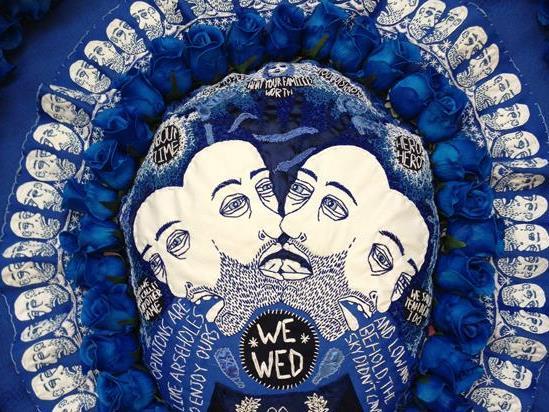Image: Lucas Grogan, The Wedding Quilt, via Lucas Grogan porfolio
Inspired collaborations between artists, designers or craftspeople and like-minded clients or colleagues can work wonders for all involved. Teaming up with individuals or companies to create quality work that’s a great creative fit for both parties and leaves each feeling valued, financially rewarded and proud of the end result is the ultimate win-win scenario. These kinds of matches made in heaven are the ones we most often read about because, naturally enough, people like discussing successful experiences that leave them upbeat and energised.
Alas, many established artists say offers to collaborate in ways that are financially exploitative or destined for disaster are at least as common as potential meetings of minds. Most have been involved in a few collaborative train wrecks, particularly early in their careers when excitement about an offer led them into projects they didn’t fully understand or assess in advance. Seasoned campaigners agree the surest route to great collaborations is research, clarification and turning down arrangements that won’t serve them well.
The money trap
Suggesting collaboration is should not be a sneaky way of asking you to work for free.
Fashion designer Angie Rehe says that even after years in the industry she’s approached almost weekly to ‘collaborate’ with companies for exposure in lieu of money. ‘Nothing makes me homicidal faster than … the word ‘exposure’,’ she says. Days before our interview she was asked to draw live at a corporate event for the glory alone. ‘I’ve learned to be firmer about what you need to be paid for something like that because it’s a great service and people are walking away with original artworks,’ Rehe says.
As an emerging artist painter and textile artist Lucas Grogan collaborated for nothing but exposure on a product that ultimately sold like hotcakes. The only thing more galling than not receiving a cent was the assumption of people around him that he’d done well from the arrangement. ‘If I get an email now with the words ‘great exposure’ from a potential collaborator I just delete it,’ he says. ‘Or sometimes they’ll offer to pay you just in product. What am I going to do with $5000 worth of girls’ clothes?’
The creativity trap
Jeweller Katheryn Leopoldseder frequently collaborates with individuals or couples on one-off pieces. She says warning bells ring when people who initially seemed to understand her aesthetic arrive for a consultation with an image of the Tiffany ring they really want but can’t afford.
‘I try to get to the bottom of what it is about that ring that they like and see if I can interpret in my own style,’ she says. If she can’t, Leopoldseder has learned to refer them to designers she thinks will be able to meet their needs – before she devotes hours to sketches and costings on a job that’s a poor creative fit.
The time trap
When you work alone you are in control of your time. Working with someone else demands conversations, meetings and consultation – and you find yourself spending time seeking agreement, waiting for responses or just needing to be open to when they want to work.
Leopoldseder is currently working with two jeweller friends on a series of events at their Abbotsford Convent studios for the upcoming Radiant Pavillion Contemporary Jewellery and Object Trail. She says it has been a creatively harmonious, mutually supportive experience but more consuming than regular work.
‘You get quite a lot more done but you might call each other up at 11 o’clock at night to work things out which you wouldn’t really do with another situation so it gets into your personal life a lot,’ she said.
Protecting yourself
Determining whether a potential collaboration is a good creative match is fundamental. For Grogan this means doing your homework about the brand, its products, markets, social media platforms and relationships with past collaborators, as well as financial arrangements you’d consider fair. ‘If you’re a bit iffy about them try to find artists who they’ve previously worked with and just contact them and ask them.’
Rehe says once a good match is established it’s critical to clarify the brief, goals, money (amount and timing), copyright ownership (on work produced together or separately), process and everyone’s roles. ‘What I have learned is you get everything absolutely clear up front before anyone does a thing and then there’s very little to argue about unless someone is simply not keeping to what they agreed to, in which case you can point it out,’ she says. ‘And if people don’t want to agree to those things in the beginning they were going to give you grief later on.’
.





